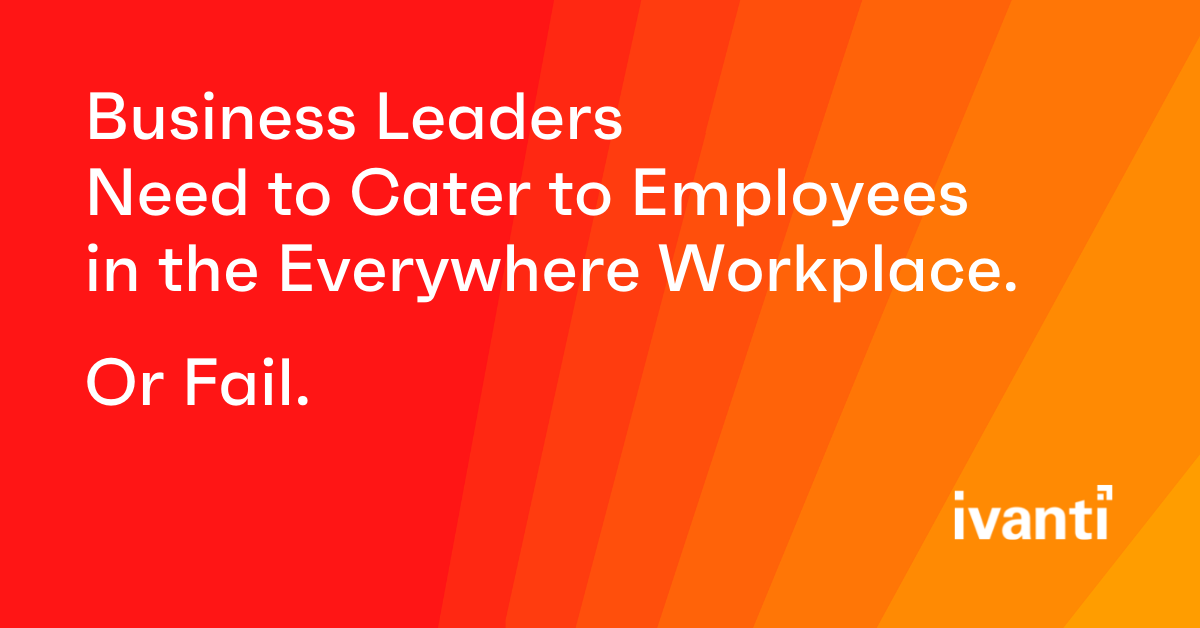Business Leaders Need to Evolve to the Everywhere Workplace. Or Fail.
The pandemic catalyzed a monumental shift in where and how people work. Amid all the uncertainty of emerging variants, returning to the old normal seems improbable. The success of the remote workforce experiment and the influx of newer generations with different work priorities also contribute to the unlikelihood of returning to offices full time. The decision of where to work is shifting from the employer to the employee. Today’s employees expect to be productive from any device and everywhere they work – the office, kitchen tables, sofas, coffee shop, or anywhere there is a hotspot – and anytime they work. They want any device to be able to access the corporate network, including wearables and other edge devices; they want the Everywhere Workplace.
And we have the numbers to back it up with the Ivanti Everywhere Workplace study. We surveyed over 6,100 office workers and IT professionals in the US, UK, Germany, Spain, Netherlands, Belgium, Sweden and Australia and worked with leading “future of work” experts to uncover employee sentiments related to the future of work.
The survey provided a massive volume of thoughtful, candid responses. I encourage each of you to view the full report here, but in the interest of efficiency, I’ve compiled a few highlights.
- 71% of employees would choose to work from anywhere over being promoted
- And 64% of employees would even take a pay cut to be able to work from anywhere
- Only 13% of employees would like to permanently return to the office full-time.
- 42% would prefer a hybrid model.
- 44% consider themselves digital nomads.
Quick math: That means 87% of respondents are saying no to full-time office work. That’s a massive shift from pre-pandemic levels, when a mere 5% of workers were remote.
There’s reason to be optimistic about this remote/hybrid future. In the Ivanti Everywhere Workplace Survey, 58% of respondents said that remote work has impacted their morale positively – and that’s a big deal given that this survey necessitated reflection on a very uncertain time in our global experience.
The top benefits of remote work were:
- Time savings due to less commuting (48%)
- Better work/life balance (43%)
- Flexible work schedule (43%)
- Saving money (40%)
That’s not to say that remote work is all sunshine. Top concerns about remote work were:
- Lack of interaction with colleagues (51%)
- Not being able to collaborate or communicate effectively (28%)
- Noise/distractions (27%)
- Screen fatigue (24%)
What does this mean? In short, to attract and retain top talent, employers have to accommodate flexible working models.
That’s where we come in. We’re here to support these employers – and employees – as they navigate this monumental change in the business landscape. The piecemeal, stopgap solutions that more or less held things together during the pandemic aren’t going to cut it anymore. We need to be vocal leaders in advocating for and supporting a comprehensive overhaul that considers issues of operations, access and security. Innovative tech solutions like ours are at the heart of making this work. Our platform enables maximum employee productivity, allows employees to interact and collaborate from wherever they are, and enhances security posture and IT efficiency. It has never been more important than it is now.
First, businesses need to make “Employee Experience” a top priority and focus on technologies that improve and secure employee experiences because it is critical for “future of work” success and retaining top talent. We are seeing a need for wider adoption and integration of employee-facing resources (cloud-based apps, self-service resources) that work for a remote environment in the channel of choice for the employee. This has challenged many organizations that don’t have streamlined request/fulfillment processes and wide access to knowledge and other resources on a self-service basis. Service catalogs, knowledge bases and other self-service tools – especially those which can be easily accessed without burdensome access processes (e.g. Zero Trust) - are gaining greater attention now that the issues have proliferated because these technologies improve employee satisfaction.
Also, in the Everywhere Workplace, hardware, software and cloud assets are no longer just confined to access from an organization’s network alone. Software and cloud assets can easily be accessed through web browsers on personal devices (that can be shared within families), integrate via marketplaces and interact with Internet of Things (IoT) devices and bots. To complicate matters, the infrastructure that supports software has evolved to meet these demands. Organizations are increasingly adopting and relying on new hybrid infrastructure to develop and deliver applications. Organizations must gain better control of IT investments and Ivanti provides the tools that enable them to do just that.
Lastly, employees need to feel safe when working. While employees didn’t cite security as a top concern, it’s certainly top of mind for IT and security professionals. The pandemic has catalyzed an alarming rise in both the frequency and sophistication of cyber threats. Remote work complicates matters as businesses try to balance facilitating access and productivity for employees while trying to keep bad actors out of a newly perimeterless workspace. Cybersecurity threats are reaching catastrophic new heights with a 30,000% increase in COVID-19 themed attacks, such as phishing, malicious websites and malware targeted at remote workers since January 2020. For growing businesses and organizations facing the overhead and uncertainty of managing their cybersecurity, Ivanti offers solutions that help organizations improve their security posture with management, automation and prioritization of their cybersecurity journey spanning across users, devices, access and applications.
Creating an Everywhere Workplace where employees can thrive is one of the biggest challenges business leaders and IT teams face today. As much of the world scrambles for top talent, it is becoming increasingly clear that the Everywhere Workplace will continue to evolve to meet the technological expectations to retain top employees. Creating a great place to work isn’t about a ping pong table, or fully stocked breakroom anymore, employees need the right tools to be their most productive and secure no matter how or where they work.

